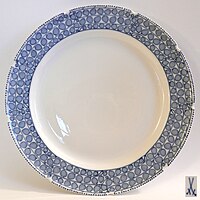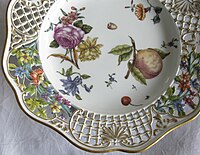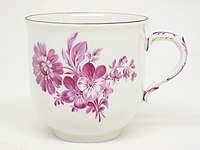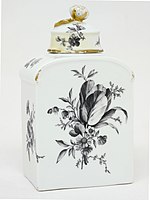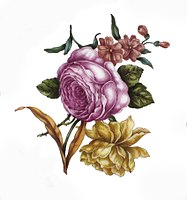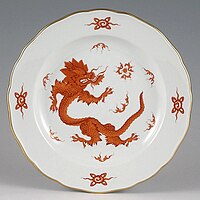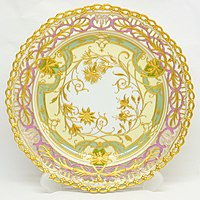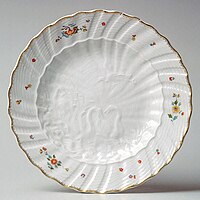Porcelain decor (list)
The porcelain decor list contains names of the articles in which porcelain decorations are described.
The names of the decors are names of porcelain - manufactures for their products and are mostly art historical origin.
Literature information on the decors can be found in the specified articles.
| decor | description | origin | image |
|---|---|---|---|
| Acanthus (ornament) | Akanthus (ending in Latin) or Akanthos (ancient Greek ὁ ἄκανθος ho akanthos "the thorny") is the archaeological-art-historical name for the type of ornament that takes up the shape of the leaves of the plant genus of the same name in a stylized form. | used on buildings in antiquity ( Corinthian capitals ) | |
| Old rich yellow lion | The Old Reicher Yellow Lion (or yellow lion for short) is an Indian decor in colorful on-glaze painting on Meissen porcelain, which was designed based on an East Asian model. It was used to decorate the first dinner service made for the Saxon court in 1728. The historical name of the decor is misleading because the yellow lion as one of the main motifs is actually a yellow, black-striped tiger that sneaks around a broken blue bamboo trunk. | Meissen Manufactory 1728 | |
| Etched gold imitation | Etched gold imitation is a common way of decorating porcelain. It is an on-glaze decoration and is based on bright gold. | Meissen Manufactory 1827 | Etched gold imitation |
| Blue panicle according to Riemerschmid | Blue panicle according to Riemerschmid is the name of a contemporary, cobalt blue underglaze decoration made from Meissen porcelain. | Art Nouveau decor designed by Richard Riemerschmid between 1903 and 1905 , Meißen manufactory | |
| Brandenstein relief | Brandenstein relief decoration is a plastic relief decoration on dishes, which imitates a certain form of wickerwork. | Designed by Johann Friedrich Eberlein and Johann Joachim Kändler for a table service for the Meissen Manufactory . 1741 | |
| Brühl's all sorts | The Brühlsche Allerlei is a relief decoration from Meißner developed for a service by Count Heinrich von Brühl. | Developed by Johann Friedrich Eberlein, Meißen manufacture | |
| Camaieu | Camaieu [kamaˈjøː] is a technical term from painting and is derived from the French camaïeu occasionally also peinture en camaïeu [pɛ̃ˈtyʁ ɑ̃ kamaˈjøː] (for camaieu painting or painted in the style of a cameo or painted like a cameo), a special monochrome painting technique . | Camaïeu paintings were already known in ancient times. | |
| German flowers | A flower depiction on porcelain that looks even more natural than woodcut flowers is called German flowers. Like these, German flowers were also painted according to botanical models, but composed in a free and natural-looking way because they were easier to adapt to the shape of the dishes. This method of representation was popular from around the 1740s to the 1770s and was used, for example, as a decoration for Meißen porcelain. It is also known as "Berlin style" or "old flower painting". | Meissen Manufactory 1740 | |
| Flora Danica | Flora Danica (Latin for "Danish flora") is the name of a botanical table set by Georg Christian Oeder. Based on this, the porcelain service of the same name from Royal Copenhagen was created by 1802. | by Georg Christian Oeder , Royal Copenhagen , 1802 | |
| Fond (porcelain) | Fond in connection with porcelain is the technical term for the large-area background painting. | The first funds go back to the porcelain from the time of the Chinese emperors of the Qing dynasty, Kangxi (1661–1722) and Yongzheng (1723–1735). | |
| Bright gold | Bright gold is a precious metal preparation for decorating glass and porcelain. | Bright gold was invented in 1827 by Heinrich Gottlieb Kühn in the Meißen manufactory . | |
| Grisaille | Grisaille (French for monotony, derived from French gris, 'gray') is a painting that is done exclusively in gray, white and black. | Grisaille is a technique that was used in particular in medieval panel painting. | |
| Woodcut flowers | Woodcut flowers are exact copies of copperplate engravings and watercolors from books on botany on porcelain. The flowers are often shown individually, the botanical features highlighted and the outline hard-drawn. | 'Woodcut flowers' appear from 1730, Meissen manufactory | |
| Indian flowers | A flower depiction on porcelain is called Indian flowers, as opposed to German flowers. For lack of better knowledge, Indian flowers were imaginatively designed flowers on East Asian porcelain in the form of stylized peonies, pomegranates, etc. in the 18th century. called. | Meissen Manufactory 1720 | |
| Indian blue | Indian blue is the name of a traditional porcelain decoration. Chinese porcelain decors were the model in the 18th century. | China | |
| Courland | The shape goes back to an order from Peter Biron, Duke of Courland, for a table service in the classical style. The service with an antique canthe, which was renamed Courland in honor of its client in the 19th century. English silver served as a design model for the relief with antique drapery hangings, egg sticks and a pearl rim. | designed by model master Johann Karl Friedrich Riese KPM Berlin around 1790 | |
| Marseille relief | Marseille relief decoration is a popular relief decoration on Meissen porcelain. | Manufactory Meißen designed by Johann Joachim KÄNDER in 1743 and 1745 . | |
| Ming dragon | Ming dragon is a popular decoration on Meissen porcelain. It has been designed according to Chinese motifs since the 18th century, with the dragon symbolizing, among other things, supernatural wisdom, the spirit of change, but also the rhythm of nature and the doctrine of becoming. | China 14th century | |
| Neuzierat | Relief decoration from rocailles and leaf branches | Berlin manufactory 1764 by Friedrich Elias Meyer | |
| East Frisian rose | The East Frisian rose is a rather abstractly painted rose that decorates the porcelain of the typical East Frisian tea set. This pattern is said to have appeared for the first time in the High Carpathians. This pattern was then used by Wallendorfer Porzellan, a company from Thuringia, as a template for decorating the tea set. | Thuringian manufactory, 18th century | |
| Ozier relief | A very popular Meißner relief decoration from the 18th century is named as the Ozier relief (French: osier = basket willow). It imitates a simple, fine-grained wickerwork endlessly parallel to the plate rim | 1733 by Johann Friedrich Eberlein Manufactory in Meissen | |
| Pâte sur Pâte | Pâte sur Pâte (French, "mass on mass") is a method of porcelain and earthenware decoration invented in China and introduced in the second half of the 19th century in the porcelain factories of Sèvres, Berlin and Meißen. The method, also known as slip painting, is used to create white, glossy and partially translucent reliefs in the form of figures and ornaments that stand out like a cameo from the colored background. To do this, thick, white porcelain mass is applied layer by layer to the wall of vessels or plates, the mass of which has already burned up but is still porous. During the fire, the applied mass melts, so that the colored background shimmers through. | China | |
| Polished gold | Polishing gold is a type of precious metal decoration for porcelain, which has to be polished after the decor firing if it is to shine. That is why it is also called unpolished gold. Polished gold is an on-glaze decoration. | known in ancient times | |
| Relief decoration also Berlin pattern | Relief decoration is the name for a decoration in which the typical element of the Frederician Rococo is used as a relief not only on the flag (the wide rim of the plate), but also in the mirror (the center of the plate). It consists of six rocaille cartridges on the rim and six relief gussets that protrude into the mirror. | Porcelain Manufactory Gotzkowsky , in 1763, for a service for the New Palace used | |
| Rocaille | Rocaille is the art-historical term for shell-shaped ornaments. Connections with leaf and tendril decorations are common. The word rocaille comes from French and means “shell work”. The rococo is also called style rocaille in French. | The first rocailles from the 16th century can be found in the grottos of palace complexes from the Renaissance period. | |
| Swan service | The swan service made for the Saxon Prime Minister Heinrich Graf von Brühl is a major work of Baroque Meissen porcelain art. | Meissen Manufactory 1737 | |
| Celadon | Celadon, also celadon ceramics and celadon, is a Chinese stoneware from the 9th to 15th centuries named after its "celadon green" (gray-green) glaze, which also found its way to Europe in isolated cases in the Middle Ages. The oldest imported celadon bowl is in the Hessian State Museum in Kassel and was owned by the Counts of Katzenelnbogen from around 1420. Celadon pottery is often decorated with reliefs. | China 14th century | |
| Everlasting flower pattern | The everlasting flower pattern is a widely used underglaze decor. Due to its adaptability, it has enjoyed great popularity since its invention in 1740 to the present day. Many variations of the decor can be found on earthenware and porcelain. Associated with this are numerous names such as blue model, Ilmenau straw flower pattern, straw flower, straw model, straw pattern, straw decor, Berlin blue model, civil onion pattern, Sachs pattern, blue saks, Indian blue, Indian blue, Frisian blue, Bergisch blue, garlic pattern, parsley pattern or blue-white . | Meissen Manufactory 1740 | |
| Sulkowski-Ozier | Sulkowski-Ozier (French: osier = basket willow) is the name of a certain braided pattern relief decoration on Meissen porcelain. The diagonal braided pattern changes like a checkerboard on the flag, which is segmented by transverse dividing bars. This relief decoration was developed for the first large dinner service commissioned by Alexander Joseph von Sulkowski, in which all parts had a uniform design. It was very popular in the 18th century and was also called ordinair ozier. | Meissen Manufactory | Sulkowski-Ozier |
| Full of green wreaths | A classic chrome-green underglaze decoration of the Meissen porcelain is called full of a green wreath or, colloquially, vine leaves. It was designed by Johann Samuel Arnhold in Meißen in 1817. The dense wreath of vine leaves with the decoratively grouped leaves is produced almost unchanged to this day. | Manufactory Meißen 1817 by Johann Samuel Arnhold | |
| Vermicelli stock | Vermicelli fond is a technical term used in porcelain painting. The name is derived from the French vermiculaire for "worm-like". It is a decorative surface that is mainly used as a background for portraits. It consists of dense, worm-like lines. It was developed in the porcelain manufactory Sèvres around 1770 and adopted by other manufacturers. | Porcelain manufactory Sèvres around 1770 | |
| Vine leaves tendrils | Vine leaves tendrils are a decoration in porcelain painting. They are made using a single color underglaze painting technique. The color used was chrome green, which was used for the first time in the Berlin manufactory in 1814 and was then adopted by other manufacturers. | Berlin Manufactory 1814 | |
| Onion pattern | The onion pattern was developed based on Far Eastern models. One of the oldest models is the blue and white porcelain from the early Ming period around 1420. | Meissen Manufactory 1730 |


